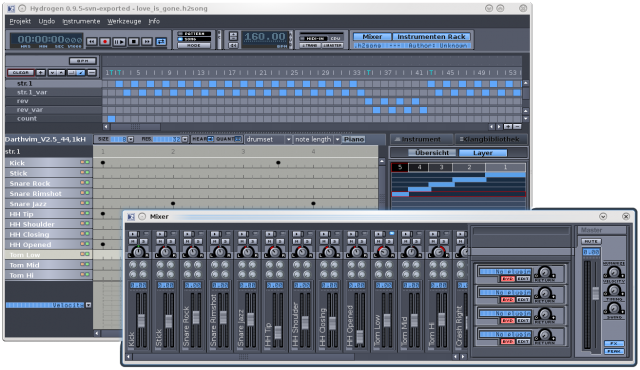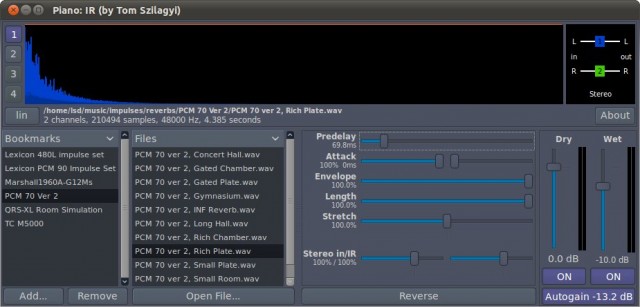There are plenty of reasons to consider free software tools as part of your toolchain for music making. They might fit your budget, give you needed flexibility, allow you to use a tool driven more by development needs than commercial ones, give you tools that would otherwise lack proprietary commercial niches, allow you to run (via Linux) on a wider variety of hardware or with greater low-latency performance, or allow you to contribute more directly to a project, from documentation to actual development. And increasingly, they don’t mandate some sort of philosophical choice, either – I routinely use free software tools on the proprietary Mac OS, and use commercial, proprietary projects (Renoise) on Linux or (Harrison Mixbus) to make free projects more powerful.
What usually holds people back from free software projects is, simply, not knowing where to begin. Software in general can overwhelm with choice; free software, often, doubly so.
Fortunately, some software gurus have jumped into the legwork so you don’t have to. I have some of my own thoughts on how to put this together, but first I wanted to share the input of these esteemed colleagues. These aren’t all Linux-only – many run on Windows and Mac, too – but if you are looking for a way to put together a robust studio on Linux, they’re a great start.
Webcast, Software Picks, Knowledge Databases
If you like real-time feedback, today, you can join Red Hat’s Adam Drew in a live webcast for “Open Your World,” entitled “Making Music with FOSS.” [Free and Open Source Software] It runs at 11:00a Pacific / 2:00p Eastern, and will be archived. (I’ll update that link here.)
Learn to make open source music–Register now for a webcast with Adam Drew
Warning: I just discovered that this thing pops up an annoying survey that assumes you use JBoss. (And, heck, CDM is indirectly a Red Hat customer – the whole site runs on RHEL.) Trying to tell it you don’t use JBoss makes the whole survey fail. I’m going to try to schedule something separately, as this is … more than a little ridiculous for a music-making survey, and sadly shows Red Hat’s blind spot in regards to end users.
Day job in tech, night job in music making – yup, that’s the M.O. of quite a few people around this community.
I asked Adam for his top picks, and he explained he would demo:
- JACK / qjackctl (the GUI for JACK), the tool for interconnecting audio, MIDI, and sync between applications
- Hydrogen Drum Machine
- Ardour, the terrific, all-free DAW
- Rakarrack, a free guitar effects tool set for Linux (one new to me, in fact!)
- ZynAddSubFX, probably the most capable free standalone soft synth – ugly, but very powerful, and a candidate for a “desert island” synth.
For additional resources, there’s a superb guide on the Fedora site (one that Ubuntu actually might mirror). It’s Fedora-focused, but the advice often applies to other distributions:
Fedora 14 Musician’s Guide
Adam himself operates the FOSS Audio KBase, full of articles on configuration and individual software programs. It’s about the most productive guide I’ve seen:
FOSS Audio KBase
Adam has some more philosophical thoughts:
Webcast preview: Free and open source software for music production [opensource.com]
And you can check out Adam’s music (CC-BY-NC-ND) and Linux-oriented personal blog. I tend to be more pragmatic about some of these issues, so I’m not endorsing all the opinions on Adam’s blog, but it’s a compelling read, and often comes with useful practical advice. (Mainly – I disagree with two points, one, I don’t think it’s entirely fair to say that proprietary DAWs lack interoperability, and two, I’m far more pragmatic about the future of Android as a platform, mainly because I think it’s currently the best bet for the distribution of free software on mobile. Oh, I don’t trust Google, either, though – that’d be silly.)
Picks from Dave Phillips of Linux Journal
Last weekend, I had the pleasure to meet Dave Phillips for the first time. Dave, an Ohio-based musician and teacher, is bar none the most invaluable writer when it comes to free software and music-making on Linux. His series for Linux Journal in particular is a must-read.
Dave and I joined Columbia’s Brad Garton at Virginia Tech to do a bit of teaching, a bit of playing, and to enjoy the hard work of the Linux Laptop Orchestra. I’ll cover more of that soon, but in the meantime, I took some notes as Dave walked through a current take on the software for Linux that most excited him.
His picks:
- Ardour, naturally
- Ardour 3, the next-generation update to Ardour that at last adds MIDI support (and beautifully executed). Dave noted that you can and should install Ardour 3 alongside the stable Ardour, so you can test both. There are even pre-built alpha binaries, so there’s really no excuse: you could be up and running in less than the time it took to read this. (See a much earlier story from Dave on testing 3.)
- Harrison Mixbus: It’s not free software, but it is now Linux-native and supports Linux plug-ins, and it’s built on Ardour (and, in turn, contributes back to Ardour). As Dave put it, Mixbus is a mind-boggling value “from a company that thinks of a budget console as costing $100,000.”
- IR: LV2 convolution reverb. The work of Tom Szilagyi, IR is a brilliant, no-nonsense plug-in for powerful convolution effects; LV2 support means it runs beautifully in hosts like Ardour 2.8.x and higher and Renoise. I’m really grateful to Dave for turning me on to this one. woo, tangent has a nice blog entry on the plug.
- LV2, generally. Dave credits the evolving state of LV2, and the work of its principle developer, David Robillard, for a lot of innovation in free software and Linux audio. I’m surprised LV2 hasn’t gained more attention, in fact – it might be the best bet yet to finally help plug-in developers escape the shadow of formats like VST. But that’s probably a topic for another article.
- RubberBand Audio Processor Powerful time stretching tool, now on Linux, Windows, and Mac OS. Available as a library, too, if you’re a developer – or just use it to mangle your audio files as an end user. Someone has already ported it to Renoise.
The focus of Dave’s presentation, though, was one tool so deep, it could easily be your only tool, for the rest of time. AVSynthesis couples visual output in OpenGL with the veritable Csound sound and composition engine. It includes built-in sequencing capabilities, basic sound generators (themselves written in Csound), envelopes and modulation, the powerful MatrixSynthMod instrument, MIDI control, and effects (phasers, choruses, filter, waveguide filter, and so on). There’s shader support on the graphics side, too. The result: based on built-in building blocks or, if you’re adventurous, your own code, you can produce 3D audiovisual musical-eye candy performances. I hope we’ll take more look at this soon; the one question that came up repeatedly – and that Dave couldn’t answer yet – was what the workflow might be for adding your own Csound creations. (The package itself is built in Java.)
More information:
http://www.avsynthesis.net/
AVSynthesis: Blending Light and Sound with OpenGL and Csound5 [Dave in Linux Journal]
Composing With Csound In AVSynthesis [Dave in Csound Journal]
Lest you think we’re all a bunch of “neckbeard” Marxist free software revolutionaries, though, Dave – who’s had drinks with Stallman on occasion – was also full of questions about Mac OS and curious about it for his own music making. I think largely we’re all technologically curious; if anything, the only people I’ve met who have gotten really emotional are the people who mistrust free software, perhaps because they just need to loosen up and accept that something really can be free.
But as with proprietary software, I think the biggest danger with Linux and free software is that you can become overwhelmed with choices rather than focusing on music. That’s part of why I find these choices so appealing: deep, capable, well-designed, and rock-solid, I’ve found them to be eminently musical. Some of the best demonstrate that free software can provide choice – not, as many believe, only compromise. And I see absolutely no reason that they can’t coexist with other popular proprietary options in your studio. You may not be ready to leap into Linux, but especially given that by now you’ve likely accumulated either extra machines or machines that can easily dual-boot, there’s no reason not to add these free tools to your arsenal.
Got favorites of your own? Let us know; I’ll continue to feature this stuff in coming days.


